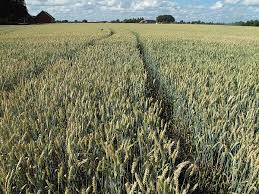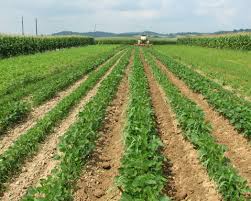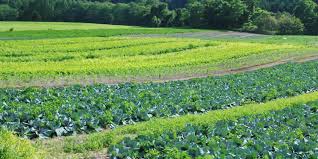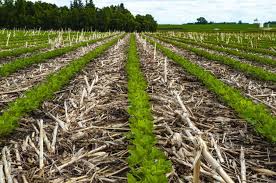The effects of continuous cropping on crop yields are significant and often lead to long-term challenges for farmers. Continuous cropping refers to the practice of growing the same crop on the same land year after year without rotation. While this approach may seem convenient and profitable in the short term, it can have detrimental effects on soil health, nutrient balance, and overall crop yields over time.
One of the main consequences of continuous cropping is soil degradation. Repeatedly growing the same crop depletes specific nutrients that the crop relies on, leading to nutrient imbalances in the soil. For example, continuous cultivation of maize can drain the soil of nitrogen and phosphorus, two essential nutrients for plant growth.
As these nutrients become less available, crop yields decrease unless farmers apply increasing amounts of fertilizers, which can lead to other issues such as soil acidification and pollution of water sources.
Another problem associated with continuous cropping is the buildup of pests and diseases. When the same crop is grown in the same field each season, it provides a stable environment for pests and pathogens to thrive.
Pests that feed on a specific crop can easily survive from one season to the next, leading to infestations that are harder to control. Similarly, soil-borne diseases specific to the crop being grown can build up in the soil, resulting in poor plant health and lower yields.
Continuous cropping also affects soil structure and organic matter. The repeated cultivation of the same crop can lead to soil compaction, which reduces its ability to retain water and air. This, in turn, affects the root development of plants and their ability to access nutrients, further reducing crop yields.
Additionally, the lack of crop rotation limits the return of organic matter to the soil. Healthy soil relies on a variety of plant residues to maintain its structure and fertility. Without this diversity, soil organic matter declines, reducing its capacity to support healthy crops.
In the long run, continuous cropping can also increase the cost of farming. To compensate for declining yields, farmers may need to invest in more fertilizers, pesticides, and soil amendments. This increases the overall cost of production, which can eat into profits. Moreover, the environmental consequences of these inputs, such as soil degradation and water contamination, can have broader impacts on ecosystems and public health.
Benefits of Continuous Cropping

1. Higher Land Productivity: Continuous cropping allows for multiple harvests on the same land within a year, maximizing land use and potentially increasing overall yields, especially in regions with favorable climates.
2. Increased Food Production: By planting crops year-round or in successive cycles, farmers can meet the growing demand for food, contributing to food security and reducing the need for fallow periods.
3. Economic Gains: Continuous cropping offers more frequent harvests, leading to more regular income for farmers, which can help improve their financial stability and long-term profitability.
4. Labor Efficiency: With continuous planting cycles, farmers can spread out their labor efforts throughout the year, potentially reducing peak workload periods and allowing for better labor management.
5. Reduced Weed Growth: Regularly cultivating crops in the same land can suppress weed growth by minimizing the amount of time the soil is bare, which reduces the opportunity for weeds to establish.
6. Better Land Utilization: Continuous cropping ensures that land is used efficiently without extended fallow periods, making it ideal for farmers with limited acreage who need to maximize production.
7. Technological Advancements: Improved farming techniques, such as irrigation and pest management systems, can support continuous cropping, making it more sustainable and less resource-intensive over time.
Soil Degradation in Continuous Cropping
1. Loss of Soil Structure: Continuous cropping can lead to soil compaction and the breakdown of soil aggregates due to frequent plowing and planting, which reduces the soil’s ability to retain moisture and support healthy plant roots.
2. Nutrient Depletion: Growing crops repeatedly without allowing the soil to rest depletes essential nutrients, such as nitrogen, phosphorus, and potassium, leading to nutrient imbalances and poorer crop performance over time.
3. Increased Soil Erosion: With little or no time for soil recovery, continuous cropping leaves the soil exposed to wind and water erosion, which can wash away topsoil, further degrading soil quality and structure.
4. Reduced Soil Microbial Activity: Continuous cropping can disrupt the natural balance of soil microorganisms, which play a key role in nutrient cycling and soil fertility, leading to a decline in soil health and biodiversity.
5. Pest and Disease Build-up: The repeated cultivation of the same crops on the same land can create ideal conditions for pests and diseases to thrive, as they have a consistent food source and habitat. This can lead to persistent pest pressures and increased chemical use.
6. Salinization Risk: In regions with poor drainage or over-irrigation, continuous cropping can exacerbate salinization, where salts accumulate in the soil, making it less suitable for crop growth.
7. Increased Dependence on Fertilizers: As the natural fertility of the soil declines, farmers may become more reliant on chemical fertilizers to maintain crop yields, which can have negative environmental effects, such as water pollution.
Impact on Soil Fertility
1. Nutrient Imbalance: Continuous cropping tends to deplete key nutrients from the soil without giving it time to regenerate, leading to nutrient imbalances that require external inputs to correct, such as synthetic fertilizers or organic amendments.
2. Organic Matter Depletion: With no fallow periods or crop rotation to introduce organic matter back into the soil, continuous cropping can result in a significant reduction in soil organic matter, which is essential for maintaining soil fertility and moisture retention.
3. Acidification: Continuous cropping, particularly of crops that require high nutrient inputs, can increase soil acidification over time, making it harder for plants to absorb essential nutrients and causing long-term fertility issues.
4. Reduced Microbial Diversity: The absence of diverse cropping patterns reduces the variety of plant residues and root exudates entering the soil, which negatively impacts the diversity and health of soil microorganisms crucial for nutrient cycling and soil fertility.
5. Diminished Soil Water-Holding Capacity: The reduction in organic matter and soil structure leads to lower water retention, making the soil more prone to drought stress and less capable of supporting plant growth without frequent irrigation.
6. Micronutrient Deficiency: Over time, continuous cropping can lead to deficiencies in essential micronutrients like zinc, iron, and copper, which are often overlooked but critical for plant health and overall soil fertility.
7. Dependency on External Inputs: As soil fertility declines, continuous cropping systems often become dependent on fertilizers and other chemical inputs to maintain productivity, which can result in long-term environmental and economic challenges.
Nutrient Depletion in Continuous Cropping
1. Depletion of Major Nutrients: Continuous cropping exhausts key soil nutrients like nitrogen, phosphorus, and potassium, as crops continuously absorb them without sufficient replenishment, leading to reduced soil fertility over time.
2. Imbalance of Soil Nutrients: As crops selectively absorb certain nutrients, continuous cropping creates an imbalance in soil nutrients, often leaving the soil deficient in specific elements necessary for healthy plant growth.
3. Increased Fertilizer Dependency: Due to nutrient depletion, continuous cropping requires frequent application of synthetic fertilizers to maintain productivity, which can lead to environmental issues like water pollution and nutrient runoff.
4. Depletion of Micronutrients: Continuous cropping also leads to the depletion of important micronutrients like zinc, copper, and manganese, which are essential for crop health and can result in reduced yields if not properly managed.
5. Reduced Organic Matter: The removal of crop residues during continuous cropping diminishes soil organic matter, which is crucial for nutrient retention, microbial activity, and overall soil health, further accelerating nutrient loss.
6. Loss of Nitrogen-Fixing Bacteria: Continuous cropping can reduce the population of nitrogen-fixing bacteria, especially in monoculture systems, decreasing the soil’s natural ability to replenish nitrogen levels.
7. Long-term Soil Fertility Decline: Over time, nutrient depletion from continuous cropping leads to a long-term decline in soil fertility, making the land less productive and requiring more intensive soil management practices to restore fertility.
Read Also: Foot-and-mouth Disease (FMD): Description, Damages Caused, Control and Preventive Measures
Effects of Continuous Cropping on Soil Structure

1. Soil Compaction: Repeated tilling and planting without allowing the soil to rest lead to soil compaction, which reduces the soil’s ability to retain air and water, impairing root development and nutrient uptake.
2. Breakdown of Soil Aggregates: Continuous cropping causes the gradual breakdown of soil aggregates, reducing the soil’s capacity to store water and nutrients and making it more prone to erosion and nutrient leaching.
3. Reduced Water Infiltration: Compacted and degraded soil structure from continuous cropping results in poor water infiltration, increasing the risk of surface runoff and reducing the availability of water to plant roots.
4. Loss of Soil Porosity: The frequent disturbance of the soil disrupts its natural porosity, decreasing the air pockets necessary for root respiration and microbial activity, leading to poorer crop performance.
5. Increased Soil Erosion: As soil structure weakens, it becomes more vulnerable to erosion by wind and water, leading to a loss of topsoil, which is the most nutrient-rich layer essential for healthy plant growth.
6. Reduced Microbial Activity: The deterioration of soil structure negatively impacts soil microbial life, particularly the beneficial microorganisms that help in breaking down organic matter and releasing nutrients for plant use.
7. Long-term Degradation of Soil Quality: Continuous cropping causes long-term degradation of soil structure, making it more difficult to restore soil health without significant soil management interventions, such as adding organic matter or reducing tillage.
Increased Pest and Disease Incidence
1. Pest Build-Up: Continuous cropping, particularly of the same crop (monoculture), creates ideal conditions for pests to thrive, as they can continuously feed and reproduce without disruption, leading to large infestations over time.
2. Increased Disease Pressure: Repeatedly growing the same crops can lead to the build-up of soil-borne pathogens, which persist in the soil and infect subsequent crops, resulting in higher disease incidence and crop losses.
3. Reduced Crop Resistance: The lack of crop diversity in continuous cropping reduces the natural resistance mechanisms that come with crop rotation, making crops more vulnerable to pest and disease attacks.
4. Increased Use of Pesticides: Due to the higher incidence of pests and diseases, farmers often resort to increased pesticide usage, which can lead to pesticide resistance, environmental contamination, and higher production costs.
5. Disruption of Natural Predators: Continuous cropping can disrupt the populations of natural pest predators, such as beneficial insects, due to habitat loss and frequent pesticide application, allowing pest populations to grow unchecked.
6. Spread of Invasive Species: The continuous disturbance of the soil and crop environment creates opportunities for invasive species (both pests and weeds) to establish themselves, making it harder to control them in future cropping cycles.
7. Long-term Pest Management Challenges: Over time, continuous cropping can create long-term pest management issues, as pests and diseases become more persistent, requiring more advanced and costly control measures.
Effects of Continuous Cropping on Crop Yields
1. Declining Yields Over Time: Continuous cropping, especially without proper soil management, leads to declining soil fertility and nutrient depletion, which directly reduces crop yields over successive seasons.
2. Increased Crop Stress: As soil structure degrades and water-holding capacity diminishes, crops become more stressed due to poor root development and nutrient uptake, leading to reduced growth and yield.
3. Vulnerability to Environmental Stress: Continuous cropping weakens the soil’s resilience to environmental stressors, such as drought or heavy rains, which can have a more severe impact on crop yields than in more diversified farming systems.
4. Diminished Crop Quality: Nutrient-depleted soils result in poorer crop quality, with lower nutritional value and reduced marketability, as crops fail to absorb essential nutrients necessary for healthy development.
5. Higher Input Costs: To maintain yields, continuous cropping often requires higher input costs for fertilizers, pesticides, and soil amendments, which can erode profitability even if yields remain relatively stable.
6. Decreased Yield Consistency: Continuous cropping leads to inconsistent yields as nutrient levels fluctuate, soil health declines, and pest and disease pressures increase, making it difficult to predict and manage crop performance.
7. Long-term Yield Decline: Over time, without proper soil and pest management practices, continuous cropping leads to a long-term decline in both the quantity and quality of crop yields, making the farming system unsustainable without intervention.
Read Also: How to Farm and Care for Longtail Tuna Fish (Thunnus tonggol)
Role of Crop Rotation in Mitigating Effects

1. Nutrient Recycling: Crop rotation helps restore soil nutrients by alternating crops with different nutrient requirements. For example, rotating legumes that fix nitrogen with nutrient-demanding crops like cereals replenishes soil fertility and reduces the need for synthetic fertilizers.
2. Breaking Pest and Disease Cycles: By changing crops, crop rotation interrupts the life cycles of pests and diseases that are specific to certain crops, reducing infestations and lowering the need for chemical pest control measures.
3. Improving Soil Structure: Crop rotation reduces soil compaction and erosion by alternating deep-rooted crops, which break up the soil, with shallow-rooted ones, enhancing soil aeration and water infiltration.
4. Enhancing Soil Biodiversity: Rotating crops promotes a diverse microbial community in the soil, which improves nutrient cycling and helps suppress soil-borne pathogens, leading to healthier soil.
5. Reducing Weed Pressure: Certain crop rotations suppress weed growth by covering the soil with crops that outcompete weeds for light, water, and nutrients, reducing the need for herbicides.
6. Better Nutrient Use Efficiency: By alternating crops that have different nutrient needs, crop rotation helps optimize nutrient use efficiency, ensuring that no single nutrient is over-depleted, leading to balanced soil health.
7. Long-Term Soil Fertility Maintenance: In the long term, crop rotation maintains soil fertility by allowing the soil to recover between planting seasons, reducing the continuous strain on nutrient reserves seen in monoculture systems.
Environmental Impact of Continuous Cropping
1. Increased Soil Erosion: Continuous cropping, especially in monoculture systems, leads to poor soil cover and compaction, making the soil more prone to erosion by wind and water, which can cause land degradation.
2. Nutrient Runoff and Water Pollution: The reliance on synthetic fertilizers in continuous cropping results in nutrient runoff, which pollutes nearby water bodies and can lead to eutrophication, harming aquatic ecosystems.
3. Loss of Soil Organic Matter: Continuous cropping reduces the organic matter in the soil, which is essential for maintaining soil structure, water retention, and nutrient availability, ultimately degrading soil health.
4. Reduction in Biodiversity: Continuous cropping, especially monocultures, reduces both aboveground and soil biodiversity, as fewer plant species are cultivated, which negatively impacts beneficial insects, soil microbes, and ecosystem health.
5. Greenhouse Gas Emissions: The frequent use of synthetic fertilizers and intensive farming practices in continuous cropping contributes to greenhouse gas emissions, particularly nitrous oxide, which exacerbates climate change.
6. Water Overuse: Continuous cropping often requires excessive irrigation, depleting local water resources and leading to issues such as groundwater depletion and reduced water availability for surrounding ecosystems.
7. Habitat Loss: As continuous cropping expands, natural habitats such as forests and wetlands may be cleared to make way for agricultural land, leading to a loss of wildlife habitats and ecological imbalances.
Long-Term Economic Effects of Continuous Cropping
1. Declining Yields Over Time: Continuous cropping without proper soil management leads to nutrient depletion and soil degradation, resulting in declining crop yields and reduced profitability for farmers in the long term.
2. Increased Input Costs: Farmers practicing continuous cropping often face higher input costs for fertilizers, pesticides, and soil amendments to maintain yields, which can erode profitability and lead to diminishing returns.
3. Soil Rehabilitation Costs: Over time, continuous cropping may require expensive soil rehabilitation measures, such as adding organic matter, implementing cover crops, or reducing tillage, to restore soil health and fertility.
4. Market Instability: Continuous cropping systems that rely on a single crop are more vulnerable to market fluctuations, pest outbreaks, or climate-related disasters, which can lead to significant financial risks and income instability.
5. Long-Term Decline in Land Value: As soil fertility and productivity decline due to continuous cropping, the value of agricultural land may decrease, making it less desirable for future use or requiring significant investment to restore.
6. Increased Dependency on Agrochemicals: Continuous cropping increases the dependency on chemical inputs such as fertilizers and pesticides, leading to higher operational costs and reduced economic sustainability.
7. Reduced Profit Margins: With increasing input costs and declining yields, continuous cropping reduces profit margins over time, making it economically unsustainable for many farmers in the long run.
Sustainable Alternatives to Continuous Cropping
1. Crop Rotation: Alternating crops with different nutrient needs and pest resistance properties helps maintain soil fertility, improve soil structure, and reduce pest pressure, making it a sustainable alternative to continuous cropping.
2. Agroforestry: Integrating trees and shrubs with crops in an agroforestry system helps enhance biodiversity, improve soil health, and provide additional sources of income, such as timber and fruit, making it an ecologically and economically sustainable practice.
3. Cover Cropping: Planting cover crops during fallow periods helps prevent soil erosion, improve soil fertility, and increase organic matter content, contributing to long-term soil health and sustainability.
4. Conservation Tillage: Reducing or eliminating tillage helps maintain soil structure, reduce soil erosion, and improve water retention, making it a more sustainable practice compared to intensive tillage in continuous cropping systems.
5. Intercropping: Growing multiple crops together on the same plot of land maximizes resource use, improves biodiversity, and reduces the risks of pest outbreaks, making it a sustainable alternative to monoculture systems.
6. Organic Farming: Utilizing organic fertilizers, natural pest management techniques, and sustainable soil management practices helps maintain soil health, reduce reliance on synthetic chemicals, and improve long-term productivity.
7. Permaculture: Implementing permaculture principles, such as designing self-sustaining agricultural systems that mimic natural ecosystems, helps improve biodiversity, conserve resources, and reduce environmental impact.
Do you have any questions, suggestions, or contributions? If so, please feel free to use the comment box below to share your thoughts. We also encourage you to kindly share this information with others who might benefit from it. Since we can’t reach everyone at once, we truly appreciate your help in spreading the word. Thank you so much for your support and for sharing!
Read Also: 9 Impressive Health Benefits of Onions

